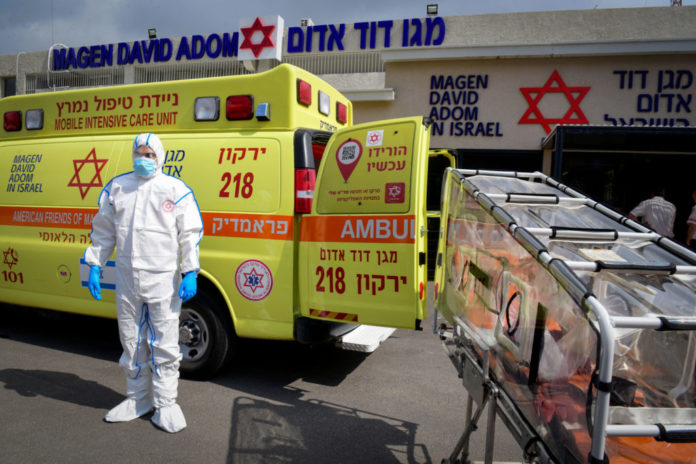

“We enjoy looking at the green part of the map, but the orange
and red part is starting to rise,” Sharon Alroy-Preis warned.
Israel’s coronavirus commissioner said the country is in a state of emergency on Tuesday, as new daily cases topped 1,200.
“There is an increase in morbidity along with a public feeling that the coronavirus is gone,” Prof. Nachman Ash said. “We will meet to think about what immediate steps should be taken as a recommendation to the coronavirus cabinet.”
On Tuesday, the Health Ministry reported 1,244 new cases the day before, plus an additional 789 between midnight and press time on Tuesday. Some 264 people were in serious condition. The death toll hit 2,877.
“Today, for the first time in more than a month, we have passed the 1,200 verified threshold per day,” said the head of Public Health Services, Sharon Alroy-Preis, during a Tuesday briefing. “During the exit from the lockdown we were at less than 600. The reproduction rate today is 1.17 and continuously increasing. We do not even know what the impact will be after all that we have opened in recent days – commerce, fifth and sixth grades returning to school. We’re watching the reproduction rate carefully.”
“The trend in infection in about 90 localities in the State of Israel is worsening. We enjoy looking at the green part of the map, but the orange and red part is starting to rise… Let’s not deceive ourselves that the whole country is in the green,” Alroy-Preis said.
There are currently 16 red cities and 27 orange, Alroy-Preis showed.
“The data worries us greatly,” she continued. “This is an emergency. We see a significant increase in morbidity and already know to recognize that this is the beginning of the third wave.”
While she said the number of daily cases is lower than in August, the reproduction rate is about the same and “it can move fast.”
“Already, we see the decline of seriously ill patients has stopped. So has the number of deaths. It is very possible that the wave of serious and dead patients will also start to rise,” she added.
“When we are in a state of infection like this one, we cannot open more,” she stressed. “The Health Ministry has made this clear.”
Rather, the Health Ministry is expected to present its ideas to the coronavirus cabinet in the coming days – ideas that are meant to help stop the spread of infection that threatens to burn across the country during Hanukkah and Christmas.
One idea that Deputy Health Minister Yoav Kisch offered on Tuesday was to implement a night closure during the Festival of Lights. He raised the idea in an interview with N12. But Alroy-Preis said that no decision was made on such a move.
“A night curfew is still under discussion and has not yet been decided,” she stressed. “We do not want to reach a general lockdown. We would not want to impose restrictions that we are not sure will help but cause distress among citizens. Therefore, we will carefully consider whether a night curfew can help.
“On Hanukkah, there may be recommendations not to hold large gatherings and there may be additional recommendations beyond that,” she said.
Ministers have been presented with several presentations in recent days, including one by the Intelligence Ministry that said the next coronavirus outbreak could not be prevented and that another closure or even more than one is inevitable.
“We are trying not to close down on the holidays,” Alroy-Preis said, though she admitted that she cannot predict what will be five days from now, let alone on Hanukkah, which starts in 10 days.
The cabinet will also evaluate a recommendation by the Health Ministry that Israel lockdown when the reproduction rate reaches 1.3 or the number of daily cases hits 2,000.
There is still no day or date set for the next meeting, though ministers are expected to convene this week.
Even if there is a lockdown, the aim is to allow the education system to remain open, as was discussed by the Knesset on Tuesday.
In recent weeks, the virus has been most dominant among the Arab sector, where until recently around 46% of new cases were from within that community. However, Alroy-Preis reported Tuesday that there has been a shift. Presently, some 50% of infection is within the general Jewish community, 41% among the Arab sector and only 9% among the ultra-Orthodox.
Nonetheless, Defense Minister Benny Gantz announced on Tuesday that a “Green Mountain” operation has been approved and will operate for three days in several Arab towns, including Ayn Kiniya, Bukata, Masada and Majdal Shams. Hundreds of Home Front Command soldiers, together with members of the health system, will be deployed in these authorities to carry out around 15,000 tests and epidemiological investigations.
Gantz also instructed that enforcement be increased to stop the entry of Israeli civilians into the Palestinian territories, especially on the weekends.
Moreover, infection rates have also been climbing from citizens returning from abroad and failing to quarantine. Less than one-third of Israeli travelers isolate as required, Alroy-Preis said.
The Health Ministry is now weighing the option of either requiring returnees to be tested at the airport and then a few days later or to mandate their quarantine in a state-run coronavirus hotel where they can be monitored.
At the same time, the Health Ministry is considering labeling the United Arab Emirates a red country, as the number of cases there climbs. Recall, Israeli airlines on Tuesday launched its first direct flight to the UAE.
(Jerusalem Post).





